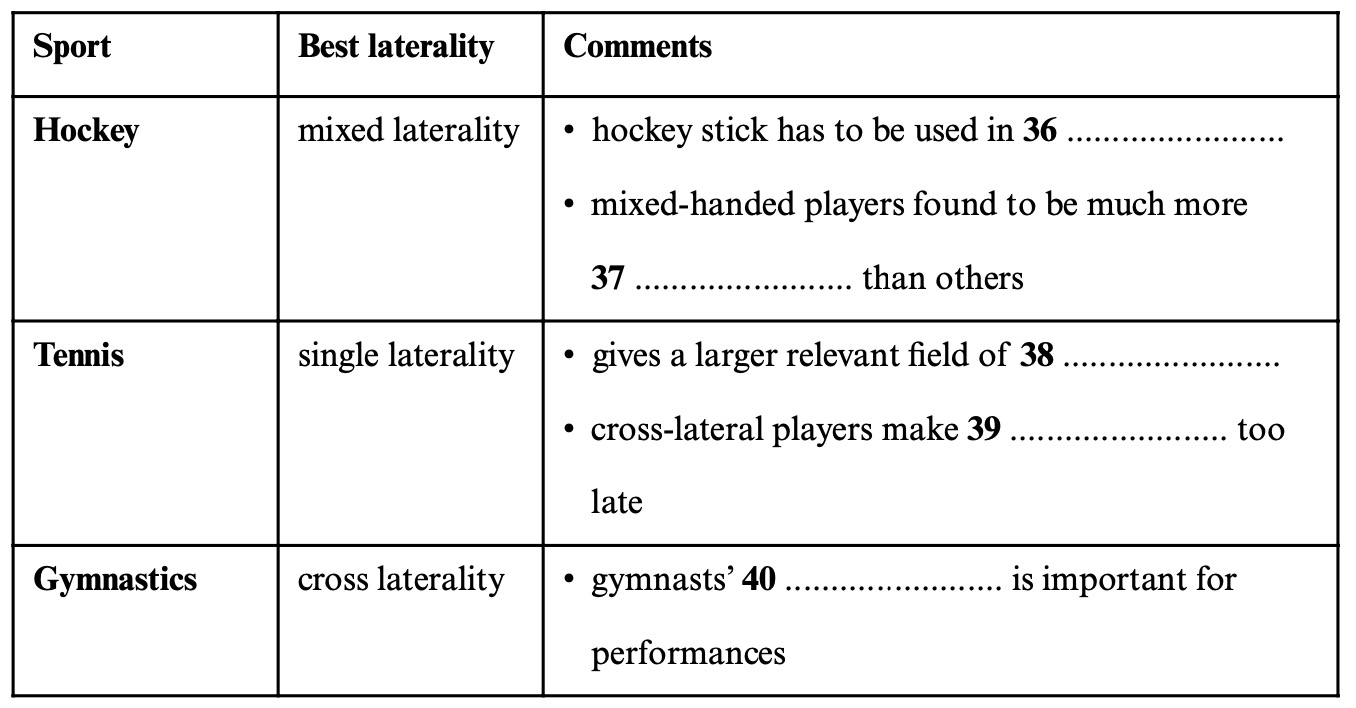Choose the correct letter, A, B or C.
A
how it would help her difficulties with left-handedness.
B
the relevance of connections he made with music.
C
the impressive size of his research project.
A
helping sportspeople identify their weaknesses.
B
aiding sportspeople as they plan tactics for each game.
C
developing suitable training programmes for sportspeople.
A
know nothing about the influence of handedness.
B
focus on the wrong aspects of performance.
C
underestimate what science has to offer sport.
A
started playing instruments in early youth.
B
play a string instrument such as the violin.
C
practise a great deal on their instrument.
A
apes which always use the same hand to get food are most successful.
B
apes have the same proportion of left- and right-handers as humans.
C
more apes are left-handed than right-handed.
Complete the table below.
Write ONE WORD AND/OR A NUMBER for each answer.

36
37
38
39
40
SECTION 4
My topic is handedness - whether in different sports it is better to be left-or right-sided or whether a more balanced approach is more successful.
我要分享的话题是关于用手习惯——具体来说就是关于是否在不同的体育比赛中左手选手或右手选手有特别的优势,还是左右手都用更容易获得成功。
I'm left-handed myself and I actually didn't see any relevance to my own life when I happened to start reading an article by a sports psychologist called Peter Matthews.
我自己是一个左撇子,当我第一次碰巧读到皮特·马修斯,一名运动心理学家的一篇关于这个话题的文章的时候,我觉得这和我似乎没什么关系。
He spent the first part of the article talking about handedness in music instead of sport, which I have to say almost put me off from reading further.
那篇文章的第一部分他并没有提到体育,而是在讨论用手习惯与音乐的关系,我几乎就不想往下读了。
But what I soon became struck by was the sheer volume of both observation and investigation he had done in many different sports and I felt persuaded that what he had to say would be of real interest.
但很快我就被他在不同的运动领域中做的大量的观察和研究所折服了,我认识到他所做的研究有深刻的现实意义。
I think Matthews' findings will be beneficial, not so much in helping sportspeople to work on their weaker side, but more that they can help them identify the most suitable strategies to use in a given game.
我认为马修斯的研究的意义不在于帮助运动员弥补自己的弱项,而在于帮助他们找到在特定比赛中应该采取的最佳策略。
Although most trainers know how important handedness is, at present they are rather reluctant to make use of the insights scientists like Matthews can give, which I think is rather short-sighted because focusing on individual flexibility is only part of the story.
尽管有很多教练员都明白用手习惯的重要性,但目前大部分人还是不愿意采用像马修斯这样的科学家的观点,我觉得这是一种短视的行为,因为研究用手习惯可不仅仅是关注身体灵活性这么简单。
Anyway, back to the article.
好吧,回到这篇文章来。
Matthews found a German study which looked at what he called 'mixed-handedness', that is, the capacity to use both left and right hands equally.
马修斯找到了一项在德国进行的关于均衡使用左右手的能力的研究,他将这个现象称为 “均衡用手”。
It looked at mixed-handedness in 40 musicians on a variety of instruments.
这项研究调查了40名各种乐器演奏家的用手习惯。
Researchers examined a number of variables, e.g. type of instrument played, regularity of practice undertaken and length of time playing instrument ... and found the following: keyboard players had high levels of mixed-handedness, whereas string players like cellists and violinists strongly favoured one hand.
研究者测量了一系列变量,比如乐器类型、练习的规律、演奏时间等等,最终发现键盘乐手的均衡用手能力最强,而弦乐手如大提琴或小提琴演奏者则通常比较偏爱用一只手。
Also those who started younger were more mixed-handed.
除此之外研究还表明练习乐器越早的人均衡用手的能力越强。
Matthews also reports studies of handedness in apes.
马修斯还报导了对猿类的用手习惯的研究。
Apes get a large proportion of their food by 'fishing' ants from ant hills.
猿类食物的一大部分来自于从蚁丘中“钓”蚂蚁。
The studies show that apes, like humans, show handedness - though for them right- and left-handedness is about equal, whereas about 85% of humans are right-handed.
研究表明猿类和人类一样也有用手偏好,不同的是猿类中左撇子和右撇子的比例基本均衡,而人类85%都是右撇子。
Studies showed that apes consistently using the same hand fished out 30% more ants than those varying between the two.
研究还发现那些一直用同一只手的猿类比使用两只手的猿类能多捕捉到30%的蚂蚁。
Matthews started researching several different sports and found different types of handedness in each.
马修斯接着研究了若干种不同的体育,从中发现了不同类型的用手习惯。
By the way, he uses 'handedness' to refer to the dominant side for feet and eyes as well as hands.
顺便要说一下,马修斯所说的“用手习惯”不仅仅意味着使用某侧手的偏好,还包括偏好用某一侧脚和眼睛的习惯。
Anyway, his team measured the hand, feet and eyes of 2,611 players and found that there were really three main types of laterality: mixed - you work equally well on both sides - both hand and eye; single - you tend to favour one side but both hand and eye favour the same side; and cross-laterality - a player's hands and eyes favour only one side but they are opposite sides.
他的团队对2611名运动员的手、脚和眼的左右偏好进行了研究,发现有三种主要的类型:第一类是两侧均衡型的,两侧的肢体和眼睛使用情况差不多;第二类是单侧型的,某一侧的肢体和眼睛使用比另一侧多;还有交叉型的,也就是肢体和眼睛的使用分别偏好不同的一侧。
Let's start with hockey.
我们先拿冰球来举例吧。
Matthews found that it was best to be mixed-handed - this is because a hockey stick must be deployed in two directions - it would be a drawback to have hand or eye favouring one side.
马修斯发现在这项运动中用手均衡的运动员有优势,原因是冰球杆需要向两个方向挥杆,如果手眼的使用偏向某一侧的话会比较吃亏。
An interesting finding is that mixed-handed hockey players were significantly more confident than their single-handed counterparts.
一个有意思的发现是,用手均衡的冰球运动员的自信心要远远高于单边用手的选手。
Things are slightly different in racket sports like tennis.
而在使用球拍的运动中,比如网球,情况就有些不一样了。
Here the important thing is to have the dominant hand and eye on the one side.
在这类运动中,最重要的是主力手和主力眼在同一侧。
This means that there is a bigger area of vision on the side where most of the action occurs.
这意味着在做动作最多的一侧有更大的视野。
If a player is cross lateral the racket is invisible from the dominant eye for much of the swing, it means that they can only make corrections much later ... and often the damage has been done by then.
如果运动员是交叉用手型的,那么当选手在用主力手挥拍的时候,他的主力眼是看不见球拍的,这样的话他只能稍后做动作的修正……而这为时已晚。
And moving to a rather different type of sport which involves large but precise movements: gymnastics.
接下来我们将目光转向另一种完全不同的运动:体操。这项运动需要大量精准的动作。
It's been found that cross hand-eye favouring is best.
研究表明在体操运动中,交叉手眼配合是最佳的选择。
The predominant reason for this is because it aids balance which is of course absolutely central to performance in this sport.
这主要是因为交叉使用手眼有助于平衡,而这正是这项运动最核心的能力。
上一题
剑7 Test 2 Section 3下一题
剑7 Test 3 Section 1